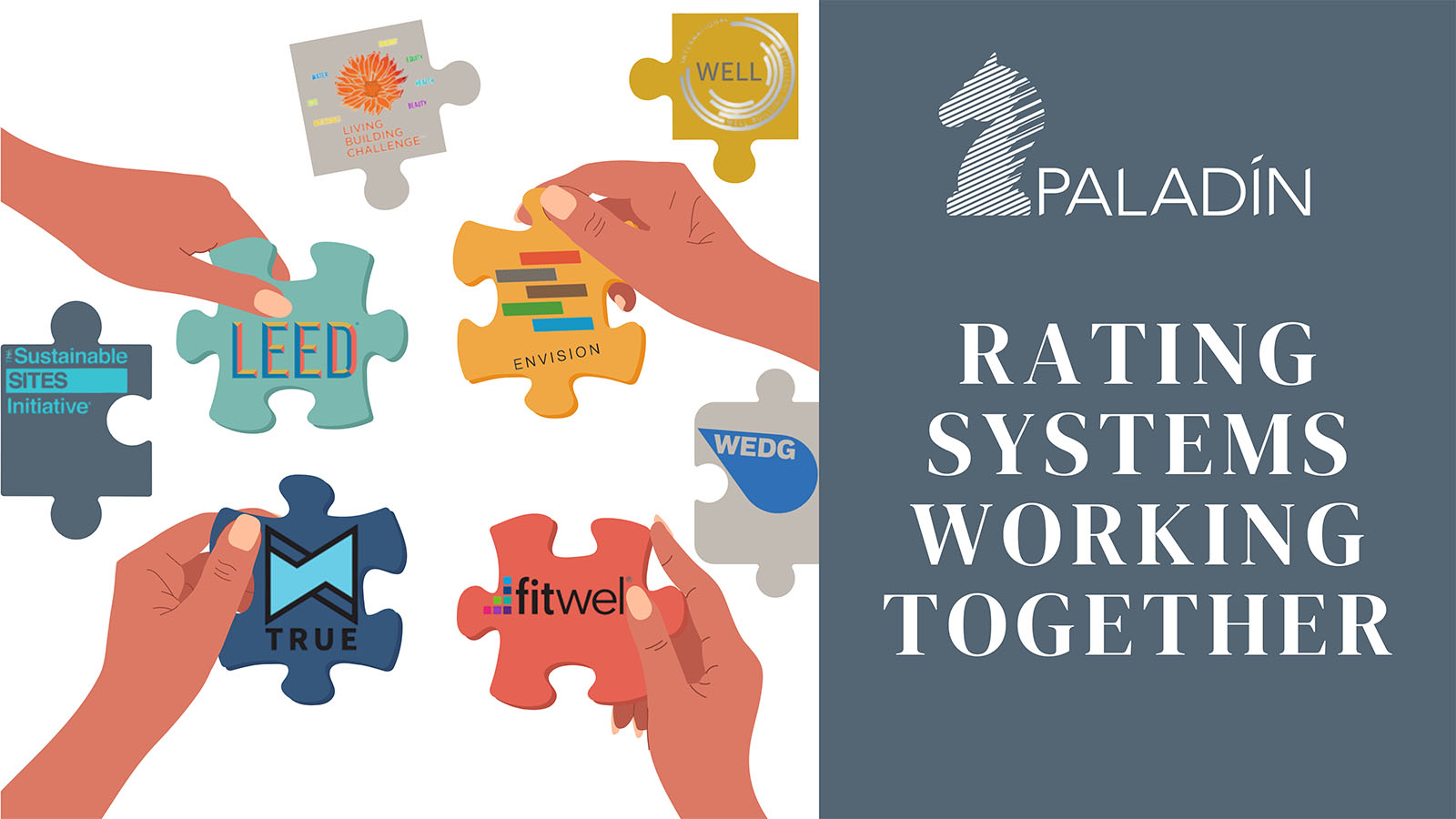By Erica Weeks, LEED Fellow
Paladin Engineers

In the past few decades, several third-party rating systems have emerged to elevate design, construction, and operations of buildings, spaces, and exterior places. While rating systems remain voluntary, there are many cities, campuses, and agencies that require a certain certification. Rating systems and certifications evolve over time and rely on many industry standards, such as those from ASHRAE, to set baselines and make comparisons.
The U.S. Green Building Council’s LEED Rating System set the bar for how to organize criteria, make the rules, and allow teams to apply for certification on a variety of project types. When LEED was launched, it was in response to the limitations of minimum energy codes, seeking to promote sustainable strategies that were obtainable, repeatable, and capable of driving market transformation—from single materials to multi-acre developments.
While LEED is comprehensive, looking at location, site development, water, energy, materials, and indoor environment, other rating systems have taken specific focus.
For example, the WELL Building Standard promotes quality indoor environments, while the SITES rating system seeks to restore land development to promote biodiversity and local ecosystems.
Even with these niche topics, rating systems can work together. A project can seek multiple certifications or utilize borrowed criteria that fit the project’s goal to enhance a particular aspect.
Today, there are many rating systems available, with some of the most widely used listed below:
Rating System
USGBC LEED – A comprehensive framework for location, site development, water, energy, materials, and indoor environment.
SITES (GBCI) – A framework for restorative land development for the promotion of biodiversity, watershed health, and ecosystem.
TRUE (GBCI) – For Zero Waste, “Total Resource Use & Efficiency.”
Living Building Challenge (International Living Future Institute (ILFI)) – A framework for transformative design, construction, and operations that allows projects to be regenerative.
The WELL Building Standard (International WELL Building Institute (IWBI)) – A framework to apply science based physical and social benefits for people.
FITWEL (Center for Active Design) – For new and existing buildings, a framework to promote positive impacts for the benefit of building occupants.
WEDG (Waterfront Edge Design Guidelines) (Waterfront Alliance) – A framework for intricate ecosystem development along bodies of water.
ENVISION (Institute for Sustainable Infrastructure) – A framework for sustainable infrastructure projects.
So how can rating systems work together?
First, when a project establishes a rating system as a goal, we ask what the owner’s intent is behind that goal. Is there a metric that they need to externally report? Are they seeking long-term energy or water savings? Are the occupants driving indoor environment conditions for comfort? Are there local ordinances for land development that drive how the site will be developed?
These questions can help identify the core reasons for pursuing a particular rating system and may lead to introducing relevant criteria from another rating system. There is often a “spark” during that questioning which allows us to introduce criteria that may be unaware to the owner. Alternatively, the project goal may get even more specific, like for energy savings only, and allow us to help focus the team’s efforts on that goal.
Frequently, the owner’s goals are driven by the length of time that they will hold and operate the building. Seeking long-term operational savings and comfortable occupants will drive decision making. This is where LEED can support energy savings, water savings, and indoor environment and also be enhanced with layers of criteria from WELL, FITWEL, or Living Building Challenge (LBC).
For example, LEED has Materials & Resources criteria and Low-Emitting Materials (low VOC) criteria. A program from ILFI called “Declare,” is a material transparency labeling program. ILFI uses the Declare label to support its Red List-free materials initiative—aimed at eliminating harmful chemicals from building products and from production in the manufacturing industry. LEED also recognizes the Declare label as one form of documentation for material ingredient transparency, awarding more points when a product is both Red List free and third-party verified.
On the Low-Emitting Materials criteria, LEED, LBC, and WELL all cite maximum targets for VOCs (Volatile Organic Compounds) based on industry standards (like SCAQMD) and require general emissions evaluations (per CDPH v1.2) to guide teams to select products that have had testing to ensure their off-gassing is very limited.
Alternatively, if the owner is seeking energy or water savings, LEED provides you with the ASHRAE standards to compare baseline to “as-designed” to evaluate how the proposed building is better than a baseline. The WELL building standard does not address efficiency so there would not be a comparable metric for “savings.”
Another example is between LEED and the TRUE rating system for zero waste during operations. In LEED v5, there is a prerequisite for “Planning for Zero Waste Operations,” which requires teams to investigate, create space and operational policies for the future occupants to successfully establish recycling, composting, and take-back programs. The TRUE rating system, although a standalone rating system, can provide guidance, ideas, and project examples that can be used to help achieve the LEED prerequisite.
As you can see, there is a wide array of criteria—shaped by evolving industry standards, methodologies, and a shared goal of market transformation. Selecting the right rating system requires thoughtful discussion to ensure the project’s success through design, construction, and long-term operations.

